经济学人双语版1
英语学习_(6-10)《经济学人》中英对照_必备

英语学习_(6-10)《经济学⼈》中英对照_必备弃我去者,昨⽇之⽇不可留乱我⼼者,今⽇之⽇多烦忧TEXT 6Travelling with baggage背着⾏囊去旅⾏Feb 16th 2006From The Economist print edition(1)FEW modern travel writers excite more hostility and awe than Sir ★Wilfred Thesiger[1], who died in 2003. Despising the “drab uniformity of the modern world”, Sir Wilfred ★slogged across [2] Africa and Asia, especially Arabia, on animals and on foot, immersing himself in tribal societies. He delighted in killing—lions in Sudan in the years before the second world war, Germans and Italians during it. He disliked “soft”living and “★intrusive[3]”women and revered murderous savages, to whom he gave guns. He thought educating the working classes a waste of good servants. He kicked his dog. His journeys were more notable as feats of ★masochistic[4] endurance than as exploration. Yet his first two books, “Arabian Sands”, about his crossing of the Empty Quarter, and “The Marsh Arabs”, about southern Iraq, have a ★terse[5] brilliance about them. As records of ancient cultures on the ★cusp[6] of ★oblivion[7], they are unrivalled.现代游记作家鲜有⼈能⽐2003年去世的威福瑞?塞西格爵⼠更令⼈敬畏。
10英语阅读-经济学人《Economics》双语版-Ominous
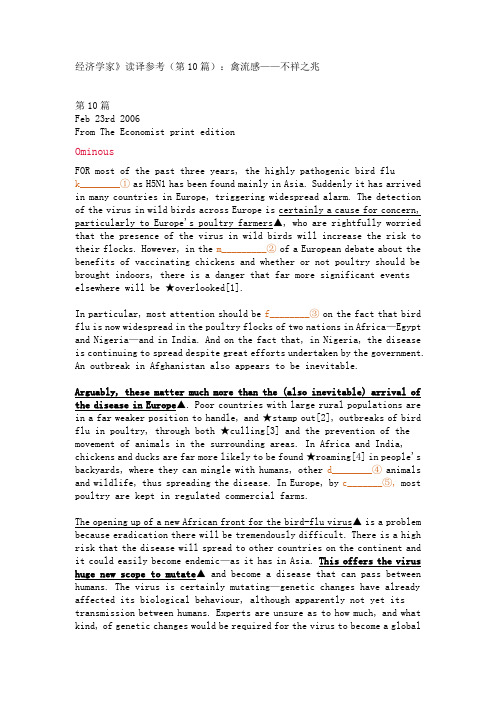
经济学家》读译参考(第10篇):禽流感——不祥之兆第10篇Feb 23rd 2006From The Economist print editionOminousFOR most of the past three years, the highly pathogenic bird fluk________①as H5N1 has been found mainly in Asia. Suddenly it has arrived in many countries in Europe, triggering widespread alarm. The detection of the virus in wild birds across Europe is certainly a cause for concern, particularly to Europe's poultry farmers▲, wh o are rightfully worried that the presence of the virus in wild birds will increase the risk to their flocks. However, in the m_________②of a European debate about the benefits of vaccinating chickens and whether or not poultry should be brought indoors, there is a danger that far more significant events elsewhere will be ★overlooked[1].In particular, most attention should be f________③on the fact that bird flu is now widespread in the poultry flocks of two nations in Africa—Egypt and Nigeria—and in India. And on the fact that, in Nigeria, the disease is continuing to spread despite great efforts undertaken by the government. An outbreak in Afghanistan also appears to be inevitable.Arguably, these matter much more than the (also inevitable) arrival of the disease in Europe▲. Poor countries with large rural populations are in a far weaker position to handle, and ★stamp out[2], outbreaks of bird flu in poultry, through both ★culling[3] and the prevention of the movement of animals in the surrounding areas. In Africa and India, chickens and ducks are far more likely to be found ★roaming[4] in people's backyards, where they can mingle with humans, other d________④ animals and wildlife, thus spreading the disease. In Europe, by c_______⑤, most poultry are kept in regulated commercial farms.The opening up of a new African front for the bird-flu virus▲ is a problem because eradication there will be tremendously difficult. There is a high risk that the disease will spread to other countries on the continent and it could easily become endemic—as it has in Asia. This offers the virus huge new scope to mutate▲ and become a disease that can pass between humans. The virus is certainly mutating—genetic changes have already affected its biological behaviour, although apparently not yet its transmission between humans. Experts are unsure as to how much, and what kind, of genetic changes would be required for the virus to become a globalhealth threat. N_____⑥ do they know how long this process might take. But to ★dwell o n[5] the increased risk of a pandemic of influenza is to miss a serious point about the direct risks posed by the loss of a large numbers of chickens and ducks across Africa. For some time, the United Nations Food and Agriculture Organisation has been warning that if avian flu gets out of c_______⑦ in Africa, it will have a devastating impact on the livelihoods of millions of people. Poultry is a vital source of protein. For example, it provides almost 50% of the protein in the diet of Egyptians. The spread of a disease that is highly lethal to poultry, and requires culling, could have a ★dire[6] nutritional impact, there as elsewhere▲. Africa would also have to contend with huge economic losses. People who ★scratch out[7] a living in poor African nations simply cannot a_______⑧to lose their chickens. Most of the world's poor live in rural areas and depend on agriculture. In Africa, rather a lot of these poor people depend heavily on their poultry. It is easy to see why some believe that bird flu could turn out to be primarily a development—rather than just a health—issue for the whole African continent.No game of chickenWhat can be done? It is clear that the movement and trade of poultry is making a big contribution to the spread of the virus. That trade needs tighter regulation, as does the movement of live birds from countries with H5N1 infections. In such places trade should be suspended u_______⑨ flocks have been cleaned up.In addition, Nigeria and surrounding countries need seriouspublic-education campaigns about the danger of contact with dead birds. When outbreaks o______⑩, governments should immediately offer realistic compensation to farmers for birds lost to disease and culling▲. Without this, poor farmers will be tempted to hide bird-flu outbreaks and continue to sell poultry that should be culled. Farming practices that mix poultry species in farms or live animal markets are a danger too, and must be addressed—although that might take longer. The effort would be helped if those in the poultry industry and governments in poultry-exporting nations would stop simply pointing to the risks posed by wild birds and start paying more attention to the movement of animals, products and people from infected to un-infected regions and countries.Unusually for a complex probl em with international ★ramifications[8], money is available to make a serious attempt at tackling it▲—$1.9 billion was pledged by the world's wealthier nations last month in Beijing. There is no excuse for delay, unless we want more dead people to followlots more dead ducks.☆★注释☆★[1]overlook vt.(1)俯瞰,俯视The house on the hill overlooks the village.从小山上的房子可以俯视村庄。
《经济学人》英中对照翻译版(考研英语必备)
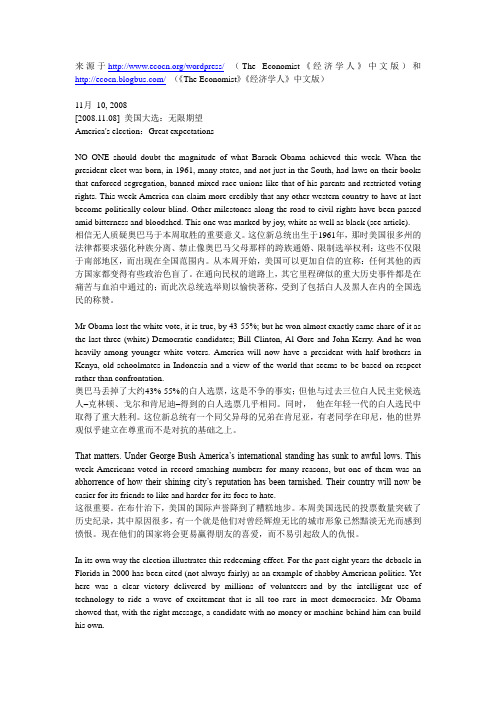
来源于/wordpress/(The Economist《经济学人》中文版)和/(《The Economist》《经济学人》中文版)11月10, 2008[2008.11.08] 美国大选:无限期望America's election:Great expectationsNO ONE should doubt the magnitude of what Barack Obama achieved this week. When the president-elect was born, in 1961, many states, and not just in the South, had laws on their books that enforced segregation, banned mixed-race unions like that of his parents and restricted voting rights. This week America can claim more credibly that any other western country to have at last become politically colour-blind. Other milestones along the road to civil rights have been passed amid bitterness and bloodshed. This one was marked by joy, white as well as black (see article).相信无人质疑奥巴马于本周取胜的重要意义。
这位新总统出生于1961年,那时美国很多州的法律都要求强化种族分离、禁止像奥巴马父母那样的跨族通婚、限制选举权利;这些不仅限于南部地区,而出现在全国范围内。
经济学人中英文
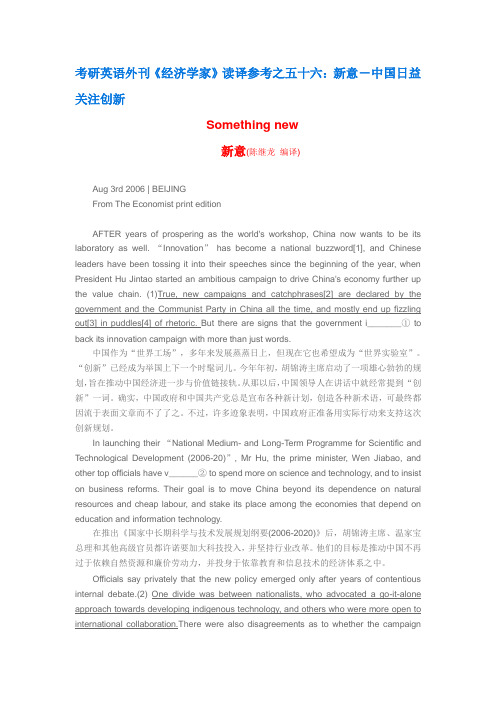
考研英语外刊《经济学家》读译参考之五十六:新意-中国日益关注创新Something new新意(陈继龙编译)Aug 3rd 2006 | BEIJINGFrom The Economist print editionAFTER years of prospering as the world's workshop, China now wants to be its laboratory as well. “Innovation”has become a national buzzword[1], and Chinese leaders have been tossing it into their speeches since the beginning of the year, when President Hu Jintao started an ambitious campaign to drive China's economy further up the value chain. (1)True, new campaigns and catchphrases[2] are declared by the government and the Communist Party in China all the time, and mostly end up fizzling out[3] in puddles[4] of rhetoric. But there are signs that the government i_______①to back its innovation campaign with more than just words.中国作为“世界工场”,多年来发展蒸蒸日上,但现在它也希望成为“世界实验室”。
“创新”已经成为举国上下一个时髦词儿。
今年年初,胡锦涛主席启动了一项雄心勃勃的规划,旨在推动中国经济进一步与价值链接轨。
重点总结的经济学人-中英文版)
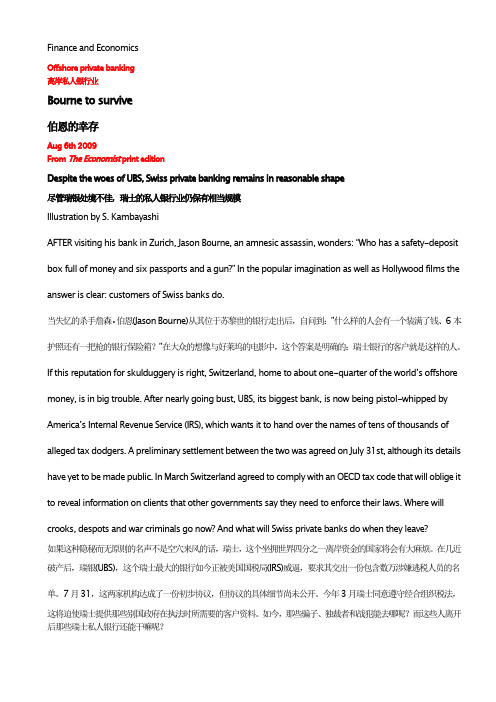
Finance and EconomicsOffshore private banking离岸私人银行业Bourne to survive伯恩的幸存Aug 6th 2009From The Economist print editionDespite the woes of UBS, Swiss private banking remains in reasonable shape尽管瑞银处境不佳,瑞士的私人银行业仍保有相当规模Illustration by S. KambayashiA FTER visiting his bank in Zurich, Jason Bourne, an amnesic assassin, wonders: “Who has a safety-deposit box full of money and six passports and a gun?” In the popular imagination as well as Hollywood films the answer is clear: customers of Swiss banks do.当失忆的杀手詹森•伯恩(Jason Bourne)从其位于苏黎世的银行走出后,自问到:”什么样的人会有一个装满了钱、6本护照还有一把枪的银行保险箱?”在大众的想像与好莱坞的电影中,这个答案是明确的:瑞士银行的客户就是这样的人。
If this reputation for skulduggery is right, Switzerland, home to about one-quarter of the world’s offshore money, is in big trouble. After nearly going bust, UBS, its biggest bank, is now being pistol-whipped by America’s Internal Revenue Service (IRS), which wants it to hand over the names of tens of thousands of alleged tax dodgers. A preliminary settlement between the two was agreed on July 31st, although its details have yet to be made public. In March Switzerland agreed to comply with an OECD tax code that will oblige it to reveal information on clients that other governments say they need to enforce their laws. Where will crooks, despots and war criminals go now? And what will Swiss private banks do when they leave?如果这种隐秘而无原则的名声不是空穴来风的话,瑞士,这个坐拥世界四分之一离岸资金的国家将会有大麻烦。
经济学人双语阅读:德国武器公司 不和武器说再见
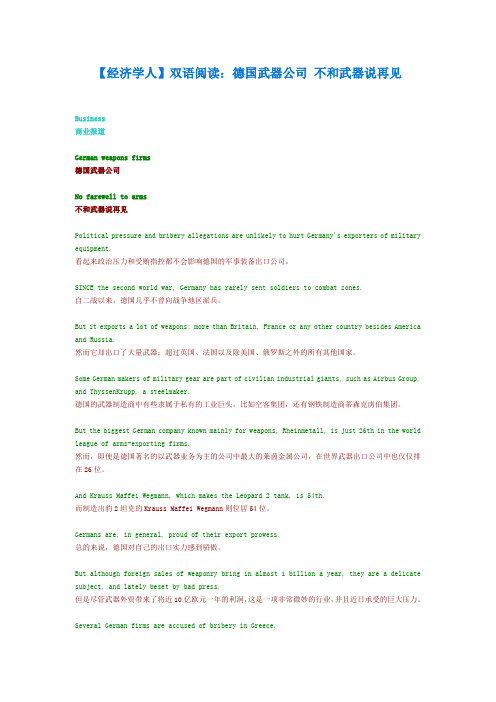
【经济学人】双语阅读:德国武器公司不和武器说再见Business商业报道German weapons firms德国武器公司No farewell to arms不和武器说再见Political pressure and bribery allegations are unlikely to hurt Germany's exporters of military equipment.看起来政治压力和受贿指控都不会影响德国的军事装备出口公司。
SINCE the second world war, Germany has rarely sent soldiers to combat zones.自二战以来,德国几乎不曾向战争地区派兵。
But it exports a lot of weapons: more than Britain, France or any other country besides America and Russia.然而它却出口了大量武器:超过英国、法国以及除美国、俄罗斯之外的所有其他国家。
Some German makers of military gear are part of civilian industrial giants, such as Airbus Group, and ThyssenKrupp, a steelmaker.德国的武器制造商中有些隶属于私有的工业巨头,比如空客集团,还有钢铁制造商蒂森克虏伯集团。
But the biggest German company known mainly for weapons, Rheinmetall, is just 26th in the world league of arms-exporting firms.然而,即使是德国著名的以武器业务为主的公司中最大的莱茵金属公司,在世界武器出口公司中也仅仅排在26位。
经济学人》杂志原版英文(The_Economist整理版4-5)
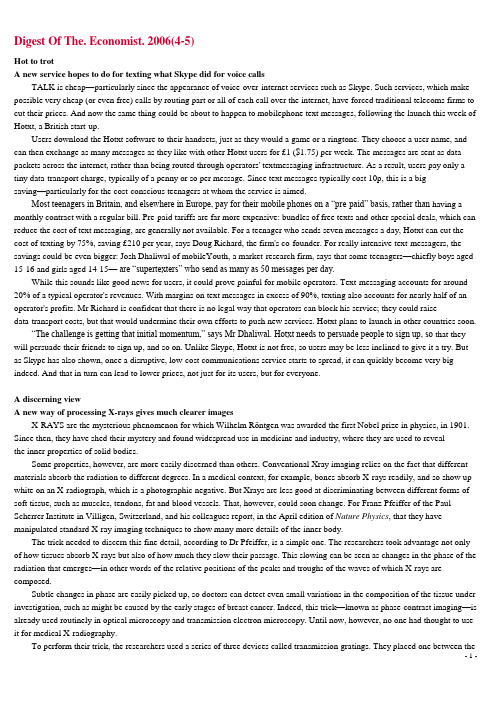
Digest Of The. Economist. 2006(4-5)Hot to trotA new service hopes to do for texting what Skype did for voice callsTALK is cheap—particularly since the appearance of voice-over-internet services such as Skype. Such services, which make possible very cheap (or even free) calls by routing part or all of each call over the internet, have forced traditional telecoms firms to cut their prices. And now the same thing could be about to happen to mobilephone text messages, following the launch this week of Hotxt, a British start-up.Users download the Hotxt software to their handsets, just as they would a game or a ringtone. They choose a user name, and can then exchange as many messages as they like with other Hotxt users for £1 ($1.75) per week. The messages are sent as data packets across the internet, rather than being routed through operators' textmessaging infrastructure. As a result, users pay only a tiny data-transport charge, typically of a penny or so per message. Since text messages typically cost 10p, this is a big saving—particularly for the cost-conscious teenagers at whom the service is aimed.Most teenagers in Britain, and elsewhere in Europe, pay for their mobile phones on a “pre-paid” basis, rather than having a monthly contract with a regular bill. Pre-paid tariffs are far more expensive: bundles of free texts and other special deals, which can reduce the cost of text messaging, are generally not available. For a teenager who sends seven messages a day, Hotxt can cut the cost of texting by 75%, saving £210 per year, says Doug Richard, the firm's co-founder. For really intensive text-messagers, the savings could be even bigger: Josh Dhaliwal of mobileYouth, a market-research firm, says that some teenagers—chiefly boys aged 15-16 and girls aged 14-15—are “supertexters” who send as many as 50 messages per day.While this sounds like good news for users, it could prove painful for mobile operators. Text-messaging accounts for around 20% of a typical operator's revenues. With margins on text messages in excess of 90%, texting also accounts for nearly half of an operator's profits. Mr Richard is confident that there is no legal way that operators can block his service; they could raisedata-transport costs, but that would undermine their own efforts to push new services. Hotxt plans to launch in other countries soon.“The challenge is getting that initial momentum,” says Mr Dhaliwal. Hotxt needs to persuade people to sign up, so that they will persuade their friends to sign up, and so on. Unlike Skype, Hotxt is not free, so users may be less inclined to give it a try. But as Skype has also shown, once a disruptive, low-cost communications service starts to spread, it can quickly become very big indeed. And that in turn can lead to lower prices, not just for its users, but for everyone.A discerning viewA new way of processing X-rays gives much clearer imagesX-RAYS are the mysterious phenomenon for which Wilhelm Röntgen was awarded the first Nobel prize in physics, in 1901. Since then, they have shed their mystery and found widespread use in medicine and industry, where they are used to revealthe inner properties of solid bodies.Some properties, however, are more easily discerned than others. Conventional Xray imaging relies on the fact that different materials absorb the radiation to different degrees. In a medical context, for example, bones absorb X-rays readily, and so show up white on an X-radiograph, which is a photographic negative. But Xrays are less good at discriminating between different forms of soft tissue, such as muscles, tendons, fat and blood vessels. That, however, could soon change. For Franz Pfeiffer of the Paul Scherrer Institute in Villigen, Switzerland, and his colleagues report, in the April edition of Nature Physics, that they have manipulated standard X-ray imaging techniques to show many more details of the inner body.The trick needed to discern this fine detail, according to Dr Pfeiffer, is a simple one. The researchers took advantage not only of how tissues absorb X-rays but also of how much they slow their passage. This slowing can be seen as changes in the phase of the radiation that emerges—in other words of the relative positions of the peaks and troughs of the waves of which X-rays are composed.Subtle changes in phase are easily picked up, so doctors can detect even small variations in the composition of the tissue under investigation, such as might be caused by the early stages of breast cancer. Indeed, this trick—known as phase-contrast imaging—is already used routinely in optical microscopy and transmission electron microscopy. Until now, however, no one had thought to use it for medical X-radiography.To perform their trick, the researchers used a series of three devices called transmission gratings. They placed one between thesource of the X-rays and the body under examination, and two between the body and the X-ray detector that forms the image. The first grating gathers information on the phases of the X-rays passing through it. The second and third work together to produce the detailed phase-contrasted image. The approach generates two separate images—the classic X-ray image and the phase-contrasted image—which can then be combined to produce a high-resolution picture.The researchers tested their technique on a Cardinal tetra, a tiny iridescent fish commonly found in fish tanks and aquariums. The conventional X-ray image showed the bones and the gut of the fish, while the phase-contrasted image showed details of the fins, the ear and the eye.Dr Pfeiffer's technique would thus appear to offer a way to get much greater detail for the same amount of radiation exposure. Moreover, since it uses standard hospital equipment, it should be easy to introduce into medical practice. X-rays may no l onger be the stuff of Nobel prizes, but their usefulness may just have increased significantly.Here be dragonsWith luck, you may soon be able to buy a mythological petPAOLO FRIL, chairman and chief scientific officer of GeneDupe, based in San Melito, California, is a man with a dream. That dream is a dragon in every home.GeneDupe's business is biotech pets. Not for Dr Fril, though, the mundane cloning of dead moggies and pooches. He plans a range of entirely new animals—or, rather, of really quite old animals, with the twist that even when they did exist, it was only in the imagination.Making a mythical creature real is not easy. But GeneDupe's team of biologists and computer scientists reckon they are equal to the task. Their secret is a new field, which they call “virtual cell biology”.Biology and computing have a lot in common, since both are about processing information—in one case electronic; in the other, biochemical. Virtual cell biology aspires to make a software model of a cell that is accurate in every biochemical detail. That is possible because all animal cells use the same parts list—mitochondria for energy processing, the endoplasmic reticulum for making proteins, Golgi body for protein assembly, and so on.Armed with their virtual cell, GeneDupe's scientists can customise the result so that it belongs to a particular species, by loading it with a virtual copy of that animal's genome. Then, if the cell is also loaded with the right virtual molecules, it will behave like a fertilised egg, and start dividing and developing—first into an embryo, and ultimately into an adult.Because this “growth” is going on in a computer, it happens fast. Passing from egg to adult in one of GeneDupe's enormous Mythmaker computers takes less than a minute. And it is here that Charles Darwin gets a look in. With such a short generation time, GeneDupe's scientists can add a little evolution to their products.Each computer starts with a search image (dragon, unicorn, gryphon, etc), and the genome of the real animal most closely resembling it (a lizard for the dragon, a horse for the unicorn and, most taxingly, the spliced genomes of a lion and an eagle for the gryphon). The virtual genomes of these real animals are then tweaked by random electronic mutations. When they have matured, the virtual adults most closely resembling the targets are picked and cross-bred, while the others are culled.Using this rapid evolutionary process, GeneDupe's scientists have arrived at genomes for a range of mythological creatures—in a computer, at least. The next stage, on which they are just embarking, is to do it for real.This involves synthesising, with actual DNA, the genetic material that the computer models predict will produce the mythical creatures. The synthetic DNA is then inserted into a cell that has had its natural nucleus removed. The result, Dr Fril and his commercial backers hope, will be a real live dragon, unicorn or what have you.Tales of the unexpectedWhy a drug trial went so badly wrongIN ANY sort of test, not least a drugs trial, one should expect the unexpected. Even so, on March 13th, six volunteers taking part in a small clinical trial of a treatment known as TGN1412 got far more than they bargained for. All ended up seriously ill, with multiple organ failure, soon after being injected with the drug at a special testing unit at Northwick Park Hospital in London, run by a company called Parexel. One man remains ill in hospital.Small, preliminary trials of this sort are intended to find out whether a drug is toxic. Nevertheless, the mishap was so seri ous that Britain's Medic ines and Healthcare products Regulatory Agency (MHRA), a government body, swiftly launched a full inquiry.On April 5th it announced its preliminary findings. These were that the trial was run correctly, doses of the drug were given as they were supposed to have been, and there was no contamination during manufacturing. In other words, it seems that despite extensive tests on animals and human-cell cultures, and despite the fact that the doses in the human trial were only a five-hundredth of those given to the animals, TGN1412 is toxic in people in a way that simply had not shown up.This is a difficult result for the drug business because it raises questions about the right way of testing medicines of this kind. TGN1412 is unusual in that it is an antibody. Most drugs are what are known as “small molecules”. Antibodies are big, powerful proteins that are the workhorses of the immune system. A mere 20 of them have been approved for human therapy, or are in latestage clinical trails, in America and Europe, but hundreds are in pre-clinical development, and will soon need to be tried out on people.Most antibody drugs are designed to work in one of three ways: by recruiting parts of the immune system to kill cancer cells; by delivering a small-molecule drug or a radioactive atom specifically to a cancer; or by blocking unwanted immune responses. In that sense, TGN1412 was unusual because it worked in a fourth way. It is what is called a “superagonistic” antibody, designed to increase the numbers of a type of immune cell known as regulatory T-cells.Reduced numbers, or impaired function, of regulatory T-cells has been implicated in a number of illnesses, such as type 1 diabetes, multiple sclerosis and rheumatoid arthritis. Boosting the pool of these antibodies seemed like a good treatment strategy. Unfortunately, that strategy fell disastrously to pieces and it will take a little longer to find out why.The result highlights concerns raised in a paper just published by the Academy of Medical Sciences, a group of experts based in London. It says there are special risks associated with novel antibody therapies. For example, their chemical specificity means that they might not bind to their targets in humans as they do in other species.Accidence and substanceTwo possible explanations for the bulk of realityTHE unknown pervades the universe. That which people can see, with the aid of various sorts of telescope, accounts for just 4% of the total mass. The rest, however, must exist. Without it, galaxies would not survive and the universe would not be gently expanding, as witnessed by astronomers. What exactly constitutes this dark matter and dark energy remains mysterious, but physicists have recently uncovered some more clues, about the former, at least.One possible explanation for dark matter is a group of subatomic particles called neutrinos. These objects are so difficult to catch that a screen made of lead a light-year thick would stop only half the neutrinos beamed at it from getting through. Yet neutrinos are thought to be the most abundant particles in the universe. Some ten thousand trillion trillion—most of them produced by nuclear reactions in the sun—reach Earth every second. All but a handful pass straight through the planet as if it wasn't there.According to the Standard Model, the most successful description of particle physics to date, neutrinos come in three varieties, called “flavours”. These are known as electron neutrinos, tau neutrinos and muon neutrinos. Again, according to the Standard Model, they are point-like, electrically neutral and massless. But in recent years, this view has been challenged, as physicists realised that neutrinos might have mass.The first strong evidence came in 1998, when researchers at an experiment called SuperKamiokande, based at Kamioka, in Japan, showed that muon neutrinos produced by cosmic rays hitting the upper atmosphere had gone missing by the time they should have reached an underground detector. SuperKamiokande's operators suspect that the missing muon neutrinos had changed flavour, becoming electron neutrinos or—more likely—tau neutrinos. Theory suggests that this process, called oscillation, can happen only if neutrinos have mass.Since then, there have been other reports of oscillation. Results from the Sudbury Neutrino Observatory in Canada suggest that electron neutrinos produced by nuclear reactions in the sun change into either muon or tau neutrinos on their journey to Earth. Two other Japanese experiments, one conducted at Kamioka and one involving the KEK partic le-accelerator laboratory in Tsukuba, near Tokyo, also hint at oscillation.Last week, researchers working on the MINOS experiment at Fermilab, near Chicago, confirmed these results. Over the coming months and years, they hope to produce the most accurate measurements yet. The researchers created a beam of muon neutrinos by firing an intense stream of protons into a block of carbon. On the other side of the target sat a particle detector that monitored the number of muon neutrinos leaving the Fermilab site. The neutrinos then traveled 750km (450 miles) through the Earth to a detector in a former iron mine in Soudan, Minnesota.Myths and migrationDo immigrants really hurt American workers' wages?EVERY now and again America, a nation largely made up of immigrants and their descendants, is gripped by a furious political row over whether and how it should stem the flood of people wanting to enter the country. It is in the midst of just such a quarrel now. Congress is contemplating the erection of a wall along stretches of the Mexican border and a crackdown on illegal workers, as well as softer policies such as a guest-worker programme for illegal immigrants. Some of the arguments are plain silly. Immigration's defenders claim that foreigners come to do jobs that Americans won't—as if cities with few immigrants had no gardeners. Its opponents say that immigrants steal American jobs—succumbing to the fallacy that there are only a fixed number of jobs to go around.One common argument, though not silly, is often overstated: that immigration pushes down American workers' wages, especially among high-school dropouts. It isn't hard to see why this might be. Over the past 25 years American incomes have become less equally distributed, typical wages have grown surprisingly slowly for such a healthy economy and the real wages of the least skilled have actually fallen. It is plausible that immigration is at least partly to blame, especially because recent arrivals have disproportionately poor skills. In the 2000 census immigrants made up 13% of America's pool of workers, but 28% of those without a high-school education and over half of those with eight years' schooling or less.In fact, the relationship between immigration and wages is not clear-cut, even in theory. That is because wages depend on the supply of capital as well as labour. Alone, an influx of immigrants raises the supply of workers and hence reduces wages. But cheaper labour increases the potential return to employers of building new factories or opening new valet-parking companies. In so doing, they create extra demand for workers. Once capital has fully adjusted, the final impact on overall wages should be a wash, as long as the immigrants have not changed the productivity of the workforce as a whole.However, even if wages do not change on average, immigration can still shift the relative pay of workers of different types. A large inflow of low-skilled people could push down the relative wages of low-skilled natives, assuming that they compete for the same jobs. On the other hand, if the immigrants had complementary skills, natives would be relatively better off. To gauge the full effect of immigration on wages, therefore, you need to know how quickly capital adjusts and how far the newcomers are substitutes for local workers.Roaming holidayThe EU hopes to slash the price of cross-border mobile calls“TODAY it is only when using your mobile phone abroad that you realise there are still borders in Europe,” lamented Viviane Reding, the European commissioner responsible for telecoms and media regulation, as she announced plans to slash the cost of mobile roaming last month. It is a laudable aim: European consumers typically pay €1.25 ($1.50) per minute to call home from another European country, and €1 per minute to receive calls from home while abroad. With roaming margins above 90%, European mobile operators make profits of around €10 billion a year from the trade, the commission estimates.Ms Reding's plan, unveiled on March 28th and up for discussion until May 12th, is to impose a “home pricing” scheme. Even while roaming, callers would be charged whatever they would normally pay to use their phones in their home countries; charges for incoming calls while roaming would be abolished. That may sound good. But, as the industry is understandably at pains to point out, it could have some curious knock-on effects.In particular, consumers could sign up with operators in foreign countries to take advantage of lower prices. Everyone would take out subscriptions to the cheapest supplier and bring them back home, says John Tysoe of the Mobile World, a consultancy. “You'd end up with a complete muddle. An operator might have a network, bu t no customers, because they've all migrated.”Another problem with Ms Reding's plan, he says, is that operators would compensate for the loss of roaming fees— thought to account for around 3% of their revenues and 5% of profits—by raising prices elsewhere. This would have the perverse effect of lowering prices for international business travellers, a big chunk of roaming traffic, while raising prices for most consumers.The commission's proposals are “economically incoherent”, says Richard Feasey of Vodafo ne, which operates mobile networks in many European countries. Imposing price caps on roaming is legally questionable, he says, and Vodafone has, in any case, been steadily reducing its roaming charges. (European regulators prevented it from doing so for three years on antitrust grounds after its takeover of Mannesmann in 2000.) Orange, another multinational operator, says it is planning to make price cuts,too. “Of course, now everybody's got price cuts,” says Stefano Nicoletti of Ovum, a consultancy.But perhaps Ms Reding's unspoken plan is to use the threat of regulation as a way to prompt action. Operators are right that her proposals make no sense, but they are charging too much all the same. So expect them to lobby hard against the proposals over the next couple of years, while quietly cutting their prices—an outcome that would, of course, allow both sides to claim victory.Devices and their desiresEngineers and chemists get togetherTHERE used to be a world of difference between treating a patient with a device—such as a fake hip or a pacemaker—and using biology and biochemistry. Different ailments required wholly different treatments, often with little in common. But that is changing as medical advances—such as those being trumpeted at the biotechnology industry's annual gathering this week in Chicago—foster combinations of surgical implants and other hardware with support from medicines. Drug-releasing stents were one of the first fruits of this trend, which increasingly requires vastly different sorts of health-care firms to mesh their research efforts.That will be a challenge. While pharmaceutical and biotech firms are always in search of the next big thing, devicemakers prefer gradual progress. Instead of hanging out with breathless entrepreneurs near America's east and west coasts, where most drug and biotechnology firms are based, many of the device-makers huddle in midwestern cities such as Minneapolis, Indianapolis and Kalamazoo. And unlike Big Pharma, which uses marketing blitzes to tell ailing consumers about its new drugs, medical-device sales teams act more as instructors, showing doctors how to install their latest creations.Several companies, however, are now trying to bring these two business cultures together. Earlier this year, for example, Angiotech Pharmaceuticals, a Canadian firm, bought American Medical Instruments (AMI). Angiotech's managers reckon their company has devised a good way to apply drug coatings to all sorts of medical paraphernalia, from sutures and syringes to catheters, in order to reduce the shock to the body. AMI makes just the sorts of medical supplies to which Angiotech hopes to apply its techniques.One of America's biggest makers of medical devices, Medtronic, has been doing joint research with Genzyme, a biotechnology company that is also keen on broader approaches to health care. Genzyme says that it was looking for better ways to treat ailments, such as coronary and kidney disease, and realised that it needed to understand better how electro-mechanical devices and information technology work. But combining its efforts with those of Medtronic “on a cultural level is very hard”, the company says. Biotechnology firms are used to much more risky projects and far longer development cycles.Another difference is that device-makers know that if a problem emerges with their hardware, the engineers will tinker around and try to resolve the glitch. Biotech and pharmaceutical firms have no such option. If a difficulty emerges after years of developing and testing a new pill, as with Merck's Vioxx, there may be little they can do about it. “You can't futz with a molecule”, says Debbie Wang, a health-care industry analyst.Strangely, says Ms Wang, some of the most promising engineering outfits were once divisions of pharmaceutical andhealth-care companies, which got rid of them precisely because they did not appear to offer the rapid growth that managers saw in prescription drugs. Guidant, a maker of various cardiovascular devices, was spun off by Eli Lilly in 1994 and a decade later became the prize in a bidding war between Johnson & Johnson and Boston Scientific, which Boston won earlier this year.Pfizer sold Howmedica, which makes joint replacements and prosthetics, to Kalamazoo-based Stryker in 1998. Anotherjoint-replacement maker, Zimmer, was spun off from Bristol-Myers Squibb in 2001. Now both those companies are looking for ways to add “anti-interactive coatings”—ie, drugs—to their business. One of the most troublesome complications in joint replacement is infection.The big drug companies might be tempted to reacquire the firms that they let go. But, given the potential for cultural and strategic clashes, it may make more sense for a few big and broad medical-device makers, such as Medtronic, Boston Scientific and St Jude Medical, to continue consolidating their own industry while co-operating, along the lines of the Medtronic-Genzyme venture, with biotech and pharmaceutical firms as they see fit. There would still be irritation; but probably less risk of wholesale rejection.Eat less, live moreHow to live longer—maybeDIETING, according to an old joke, may not actually make you live longer, but it sure feels that way. Nevertheless, evidence has been accumulating since the 1930s that calorie restriction—reducing an animal's energy intake below its energy expenditure—extends lifespan and delays the onset of age-related diseases in rats, dogs, fish and monkeys. Such results have inspired thousands of people to put up with constant hunger in the hope of living longer, healthier lives. They have also led to a search for drugs that mimic the effects of calorie restriction without the pain of going on an actual diet.Amid the hype, it is easy to forget that no one has until now shown that calorie restriction works in humans. That omission, however, changed this month, with the publication of the initial results of the first systematic investigation into the matter. This study, known as CALERIE (Comprehensive Assessment of Long-term Effects of Reducing Intake of Energy), was sponsored by America's National Institutes of Health. It took 48 men and women aged between 25 and 50 and assigned them randomly to either a control group or a calorie-restriction regime. Those in the second group were required to cut their calorie intake for six months to 75% of that needed to maintain their weight.The CALERIE study is a landmark in the history of the field, because its subjects were either of normal weight or only slightly overweight. Previous projects have used individuals who were clinically obese, thus confusing the unquestionable benefits to health of reducing obesity with the possible advantages of calorie restriction to the otherwise healthy.At a molecular level, CALERIE suggests these advantages are real. For example, those on restricted diets had lower insulin resistance (high resistance is a risk factor for type 2 diabetes) and lower levels of low-density lipoprotein cholesterol (high levels are a risk factor for heart disease). They showed drops in body temperature and blood-insulin levels—both phenomena that have been seen in long-lived, calorie-restricted animals. They also suffered less oxidative damage to their DNA.Eric Ravussin, of Louisiana State University in Baton Rouge, who is one of the study's authors, says that such results provide support for the theory that calorie restriction produces a metabolic adaptation over and above that which would be expected from weight loss alone. (He also points out that it will be a long time before such work reveals whether calorie restriction actually extends life.) Nevertheless, such metabolic adaptation could be the reason why calorie restriction is associated with longer lifespans in other animals—and that is certainly the hope of those who, for the past 15 years, have been searching for ways of triggering that metabolic adaptation by means other than semi-starvation.The search for a drug that will stave off old age is itself as old as the hills—as is the wishful thinking of the suckers who finance such efforts. Those who hope to find it by mimicking the effect of calorie restriction are not, however, complete snake-oil salesmen, for there is known to be a family of enzymes called sirtuins, which act both as sensors of nutrient availability and as regulators of metabolic rate. These might provide the necessary biochemical link between starving and living longer.Universal service?Proponents of “software as a service” say it will wipe out traditional softwareSOMETHING momentous is happening in the software business. Bill Gates of Mi crosoft calls it “the next sea change”. Analysts call it a “tectonic shift” in the industry. Trade publications hail it as “the next big thing”. It is software-as-a-service (SaaS)—the delivery of software as an internet-based service via a web browser, rather than as a product that must be purchased, installed and maintained. The appeal is obvious: SaaS is quicker, easier and cheaper to deploy than traditional software, which means technology budgets can be focused on providing competitive advantage, rather than maintenance.This has prompted an outbreak of iconoclasm. “Traditional software is dead,” says Jason Maynard, an analyst at Credit Suisse. Just as most firms do not own generators, but buy electricity from the grid, so in future they will buy software on the hoof, he says. “It's the end of software as we know it. All software is becoming a service,” declares Marc Benioff of , thebest-known proponent of the idea. But while SaaS is growing fast, it still represents only a tiny fraction of the overall software industry—a mere $3.35 billion last year, estimates Mr Maynard. Most observers expect it to be worth around $12 billion by 2010—but even that is equal only to Microsoft's quarterly sales today. There is no denying that SaaS is coming. But there is much debate, even among its advocates, about how quickly it will grow, and how widely it will be adopted.At the moment, small and medium-sized businesses are the most enthusiastic adopters of SaaS, since it is cheaper and simpler than maintaining rooms of server computers and employing staff to keep them running. Unlike the market for desktop software,。
最新-经济学人中英文版1 精品
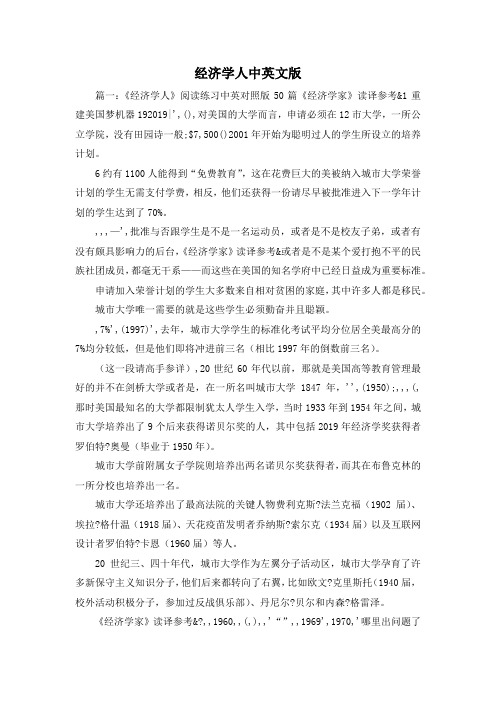
经济学人中英文版篇一:《经济学人》阅读练习中英对照版50篇《经济学家》读译参考&1重建美国梦机器192019|',(),对美国的大学而言,申请必须在12市大学,一所公立学院,没有田园诗一般;$7,500()2001年开始为聪明过人的学生所设立的培养计划。
6约有1100人能得到“免费教育”,这在花费巨大的美被纳入城市大学荣誉计划的学生无需支付学费,相反,他们还获得一份请尽早被批准进入下一学年计划的学生达到了70%。
,,,—',批准与否跟学生是不是一名运动员,或者是不是校友子弟,或者有没有颇具影响力的后台,《经济学家》读译参考&或者是不是某个爱打抱不平的民族社团成员,都毫无干系——而这些在美国的知名学府中已经日益成为重要标准。
申请加入荣誉计划的学生大多数来自相对贫困的家庭,其中许多人都是移民。
城市大学唯一需要的就是这些学生必须勤奋并且聪颖。
,7%',(1997)',去年,城市大学学生的标准化考试平均分位居全美最高分的7%均分较低,但是他们即将冲进前三名(相比1997年的倒数前三名)。
(这一段请高手参详),20世纪60年代以前,那就是美国高等教育管理最好的并不在剑桥大学或者是,在一所名叫城市大学1847年,'',(1950);,,,(,那时美国最知名的大学都限制犹太人学生入学,当时1933年到1954年之间,城市大学培养出了9个后来获得诺贝尔奖的人,其中包括2019年经济学奖获得者罗伯特?奥曼(毕业于1950年)。
城市大学前附属女子学院则培养出两名诺贝尔奖获得者,而其在布鲁克林的一所分校也培养出一名。
城市大学还培养出了最高法院的关键人物费利克斯?法兰克福(1902届)、埃拉?格什温(1918届)、天花疫苗发明者乔纳斯?索尔克(1934届)以及互联网设计者罗伯特?卡恩(1960届)等人。
20世纪三、四十年代,城市大学作为左翼分子活动区,城市大学孕育了许多新保守主义知识分子,他们后来都转向了右翼,比如欧文?克里斯托(1940届,校外活动积极分子,参加过反战俱乐部)、丹尼尔?贝尔和内森?格雷泽。
- 1、下载文档前请自行甄别文档内容的完整性,平台不提供额外的编辑、内容补充、找答案等附加服务。
- 2、"仅部分预览"的文档,不可在线预览部分如存在完整性等问题,可反馈申请退款(可完整预览的文档不适用该条件!)。
- 3、如文档侵犯您的权益,请联系客服反馈,我们会尽快为您处理(人工客服工作时间:9:00-18:30)。
Europe's debt crisis欧洲债务危机Spot the pattern看变化模式Jul 5th 2011, 18:55 by R.A. | WASHINGTON2011年7月5日18:55 R.A./华盛顿HERE'S a chart showing the yields on 10-year Greek debt over the past three months. See the pattern?本图显示的是在过去3个月10年期希腊债券的收益率。
变化模式看清楚了吧?There's a spike, followed by a decline, followed by a higher spike, followed by a decline to a higher trough, and so on. European leaders keep taking steps to avert disaster, and each time markets are less assuaged.有个尖峰,接着是下跌,然后又是稍高一些的尖峰,接着跌入一个较高的波谷,如此反复。
欧洲国家的领导人一直在采取措施避免灾难,而每一次市场都没有大的起色。
The latest spike corresponds to the stalemate over the IMF's willingness to continue making bail-out payments without a new, long-term rescue package in place (and the corresponding disagreement over how to rollover Greek debt, plus the drama surrounding the passage of Greece's new austerity plan). The IMF agreed to keep paying, French and German banks seemed willing to sign on to a rollover plan, and Greece got its new austerity programme through parliament. But it wasn't long before trouble kicked up again.最近的尖峰反映了这样一个困境:国际货币基金组织愿意继续救助,但又没有制定出一个长期的一揽子救助计划(同时也反映出如何缓解希腊债务各方存在分歧,以及希腊的新紧缩计划能否通过依然有变数)。
国际货币基金组织同意继续提供支付,法国和德国的银行似乎愿意签署资金周转计划书,希腊国会通过了新的紧缩计划。
但是,没过多久,麻烦又来了。
Moody's and Standard and Poor's have both suggested that the agreed-upon rollover plan might well constitute a default. Since that's precisely the outcome European leaders were hoping to avoid, this news has sent everyone scurrying to come up with a new and better deal. Meanwhile, Moody's has cut Portugal's debt rating to junk. Portugal may well need a new rescue package, which will surely include debate over the fate of creditors, which will mean more questions about bank finances and more brinksmanship. And the European economy continues to slow, even as the European Central Bank continues to tighten policy.穆迪和标准普尔都暗示,商定好的周转计划很可能得不到执行。
因为这种结果正是欧洲国家的领导人们想避免的,所以这条消息让每个人都急不可待地要制定出一个新的、更好的解决办法。
与此同时,穆迪公司已经将葡萄牙的债务评级降至垃圾级。
葡萄牙很可能需要一个新的一揽子救援计划,这必将包括对债权人命运的辩论,而辩论的内容将更多的是关于银行财政方面的问题和边缘政策。
欧洲经济增长速度持续放缓,尽管欧洲央行继续收紧货币政策。
I don't know that there's any broad lesson here, other than: for all the steps already taken by European leaders, the euro zone hasn't really gotten any closer to solving the underlying issues of insolvency and institutional weakness.除了以下教训,我不知道还有什么更大的了:虽然欧洲国家的领导人们已经采取了各种措施,但是,欧元区要解决当前国家破产危机和体制上不健全的根本问题,确确实实还有很长的路要走。
Global house prices全球房价Rooms with a view一览全球楼市Asia’s frothiest housing markets are calming down. Is America’s bottoming?亚洲泡沫最多的楼市不再蒸蒸日上。
美国的楼市触底了吗?Jul 7th 2011 | WASHINGTON, DC | from the print editionTHE bubble that caused a global recession has been a long time deflating. The American housing market began to decline half a decade ago and hasn’t stopped yet. Prices dropped by 5.1% from the year before, according to the latest S&P/Case-Shiller national index. Among markets tracked by The Economist, only Irish homes have fallen further since 2006. Robert Shiller, one of the fathers of the Case-Shiller index, says more hard times lie ahead. Prices may slide another 10-25%, he reckons, as the economy wrings out the excess supply of the bubble years.引发全球经济衰退的泡沫一直在破灭,已经历时已久。
5年前,美国的楼市就开始衰退了,目前还未停止衰退。
根据最新的标普凯斯•席勒全国指数,与一年前相比,房价下跌了5.1%。
在《经济学人》追踪的市场中,自2006年以来只有爱尔兰的房价跌得还要厉害。
凯斯•席勒指数创始人之一的罗伯特•席勒表示,艰难时期还在后头。
他估计,随着经济逐渐耗尽泡沫时期过剩的供应量,房价可能还要再下跌10%-25%。
By our calculations, however, America’s h ousing market has overshot the fair-value mark, as measured by the long-run average ratio of house prices to rents. Rents are rising: an increase in the cost of rental housing contributed to May’s robust American inflation data. With home ow nership looking a better deal, prices should stabilise. The Case-Shiller index posted a month-on-month increase in April for the first time since July 2010. It was not alone in showing gains. The Federal Housing Finance Agency (FHFA) price series ticked up in April for the first time since May 2010, and the CoreLogic index of home prices, a favourite of the Federal Reserve, notched price rises in both April and May. The pace of sales has been sluggish but an index of pending home sales posted a surprisingly large gain in May.然而,据我们的统计,通过长期的房价和租金的平均比率来衡量,美国的楼市已经超过合理价值的标准。
租金正在上涨:租房成本上升带来了5月份美国强劲的通胀数据。
随着拥有住房看起来是更好的选择,房价应该会稳定下来。
自2010年7月以来,4月凯斯•席勒指数首次出现了环比上扬。
并非只有凯斯•席勒指数呈现了上行趋势。
自2010年5月以来,联邦住房金融局的价格系列指数在4月份也出现了首次上升。
此外,CoreLogic房价指数(美联储最喜欢参照的指数)在4、5月份都有所上升。
尽管销售速度一直相当缓慢,但是住房销售的预期指数在5月份大幅上升,令人吃惊。
